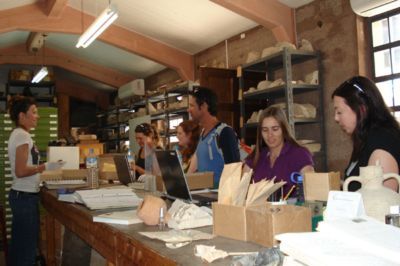2008 Excavation Season Finishes at Corinth
Nine regular and associate members worked in the session, with most having participated in the second session as well. Four teams excavated in and around a Middle Byzantine house in an area opened in the 1960s by Henry Robinson. Jody Cundy (ASCSA 2006) and Megan Thomsen excavated inside the house’s courtyard, skillfully peeling off six to ten floor surfaces in various places. The team uncovered a stone-lined drain which was cut by a manhole previously explored in the 1960s. Not surprisingly, finds from the courtyard were small and fragmented having been crushed and trampled. Sarah Lima excavated in spaces northwest and west of the courtyard and revealed robbing actions that are crucial to understanding the building's construction phases. Eagle-eyed Sarah hit upon one of the season’s most spectacular finds: a golden seal ring impressed with a half-clothed Anadyomene Aphrodite, a type that dates from the 3rd c. BC to 1st c. AC. The ring was a survivor in a later context. Emily Rush and Anne Feltovich excavated two rooms to the south of the court. They found several Byzantine coins which were helpful in dating the phases of the structure, and they excavated a series of floors and thresholds which helped explain how the structure was reused over time. To the north, Thanos Webb excavated immediately outside of the house and adjacent to Broneer’s South Stoa excavations. He dug Byzantine layers that included several pits and a robbing trench before discovering a dump of iron that contained several keyhole plates, lock mechanism fragments and other door trappings.
In the large area to the south opened last year, Joey Lillywhite, Joel Rygorsky and, for one week, Marty Wells supervised two teams of workmen. They continued removing Frankish layers and fills associated with several rooms of a partially uncovered structure. From these deposits came a nearly complete table amphora. A floor was exposed in the southern area of excavation that may be Late Byzantine.
Alicia Carter (ASCSA 2005) and Sarah James (ASCSA 2004) assisted the director in the field and in the pot sheds, respectively. Thanos Webb did double duty identifying animal skeletal remains and Christina Kolb worked with the curator in the museum. Study and clean up will continue until the end of June.

Jody Cundy, Sarah Lima, Megan Thomsen, Thanos Webb, Anne Feltovich and Emily Rush
during a Saturday morning small finds session in the museum.